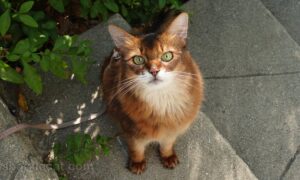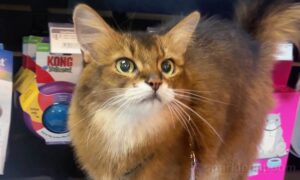

It’s not only common knowledge that cats prefer to drink running water over a still bowl — and science backs up the benefits. And lots of cats enjoy drinking from the bathroom or kitchen faucet.
Over the past couple of decades, pet fountains have become very popular. Most cats are pretty enthusiastic about them — but some stop using them after a period of time. There are a couple of reasons for that, and generally they are pretty easy to solve.
But first let me explain the appeal of running water to cats in the first place.


Cats and Running Water — a Winning Combo
The reasons why cats prefer an active drinking source are partially instinctual, partly biological, and partly, well, just because.
- Running water is perceived to be cleaner and fresher than still water.
In the wild, cats have always gravitated toward streams for their hydration. Stagnant water can be loaded with bacteria and slime. The fresh water coming from a stream is cool and refreshing. Which would you choose?
- Running water smells better than still water.
Cats have extremely sensitive noses, so if a water source smells off, even a tiny bit, they won’t want to drink from it. Still water can start smelling bad (especially if you are a cat) pretty quickly. Water that circulates stays fresher longer.
- Running water is more interesting to feline eyes and ears.
In fact, the same can be said for people! Isn’t the sound of a water fountain relaxing? And what about the sight of running water glistening as it falls? It’s like the original meditation tool. No wonder cats like it.
- Running water is just plain fun.
When you were a kid, did you ever like to play in the water? So do some cats! Yes, cats don’t like getting wet, but that’s mostly about being drenched. It won’t stop them from pawing at running water or even sticking their heads underneath a faucet.
So What’s the Deal with Water Fountains? Why Would They Be Less Desirable to a Cat?
Actually, most cats love water fountains, if they are assembled and maintained properly. But if your cat has stopped using yours, here are some reasons.
It’s the wrong material.
Cats have preferences when it comes to the fountain they’re drinking out of. And for good reason. Here are the ones you’ll find when shopping for a fountain.
- Stainless steel fountains are best.
Stainless steel is the easiest to keep clean, and the least likely to get moldy and icky. It’s also the most expensive. But if you care for it properly, it’ll last the longest.
- Ceramic fountains are prettier, and almost as good.
Like stainless steel, they are easy to keep clean — but they are also a little more fragile. And make sure you get a good quality ceramic fountain from a reputable company. That no-name company’s fountain with the pretty look and low price may contain lead.
- Plastic is the least desirable.
Sure, they’re cheap, but they scratch easily, which could harbor bacteria. And if they are not BPA-free, they could leach chemicals. Plastic fountains are usually the ones to start smelling bad first, and your cat will notice that way before you do.Ironically, my current fountain is plastic! I got it for a sponsored social media post. But my human asked a lot of questions about it first. It’s actually very sturdy and definitely BPA free, but because of tariffs, it’s currently not available in the U.S. (Apparently it’s the only country where you can’t buy it!) I like it, and it’s the easiest fountain my human has ever cleaned, but I’m pretty sure my next fountain won’t be plastic.
The Main Reason Your Cat Rejects the Water Fountain
It’s very simple — it’s lost its appeal, either because you aren’t properly maintaining it, or the wear over time has turned it a little icky. (The latter is especially true for plastic fountains.)
Regularly maintaining a fountain really matters to your cat. If the water smells a little weird, or tastes a little slimy, it could put them off the fountain, possibly for good. You wouldn’t like it, either! And if you live in an area with hard water, mineral deposits can build up pretty quickly too. That’s another concern.
So it’s important that you clean the fountain and change its filter at least as often as the instructions tell you. In addition, you should check all the moving parts to make sure nothing moldy or slimy has accumulated.
Wash the fountain with soap and water, and use a vinegar and water solution for any buildup. Air drying the fountain, or wiping it dry with a clean soft cloth (not a paper towel) is a good idea.
Other Reasons Your Cat May Dislike the Fountain
These may surprise you — but they could solve your problem!
- You’re using the wrong type of water.
My human prefers to drink mountain spring water. I prefer purified water! She discovered this because when she fills up my fountain with mountain spring water, I wait for the filter to cycle through and purify it before really drinking from it. You’d think I’d prefer the mountain spring water, but no. Who knew? So perhaps the same could be true of your cat.
- Yes, whisker fatigue can apply to water fountains.
One of the reasons cats like faucets is because they don’t have to stress out their whiskers to drink. And most water fountains solve this issue with a “fountain” like design. But if yours is like mine, with a flatter surface, some cats may not find that as appealing. Watch your cat when they drink water, because that may help show you the best choices for them when it comes to fountains.


I hope this has helped you demystify pet fountains for your cat! Do I have any recommendations? Other than what I’ve mentioned above as far as the material it’s made of, no. Because all cats are different, and what may appeal to one may not appeal to another.
So what are your cats’ experiences with water fountains? Let me know in the comments!



















